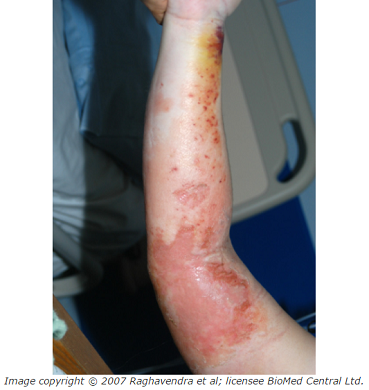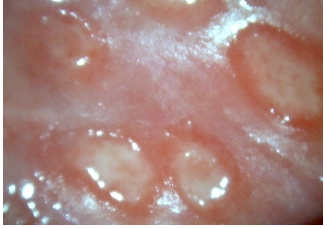Check out today’s Step 2 CK Qmax Question Challenge.
Know the answer? Post it in the comments below! Don’t forget to check back for an update with the correct answer and explanation (we’ll post it in the comments section below).
 A 20-year-old woman presents to the emergency department with complaints of 1 day of headache and fever with associated nausea, vomiting, and a diffuse red rash. She reports she has been on spring break for the past week, during which time she has been drinking heavily and spending most of each day in the sun, either hiking or on the beach. However, she has used SPF 30 sunblock and does not remember getting a sunburn. Her last menstrual period began 3 days ago. She denies any recent sexual activity. Examination is notable for a diffuse rash (pictured) that includes her palms and soles. Her neck is supple and she does not exhibit any photophobia or signs of intoxication. Twenty minutes after presentation she becomes lethargic, and her temperature is 39.6°C (103.3°F), heart rate is 115/min, blood pressure is 84/48 mm Hg, and respiratory rate is 18/min.
A 20-year-old woman presents to the emergency department with complaints of 1 day of headache and fever with associated nausea, vomiting, and a diffuse red rash. She reports she has been on spring break for the past week, during which time she has been drinking heavily and spending most of each day in the sun, either hiking or on the beach. However, she has used SPF 30 sunblock and does not remember getting a sunburn. Her last menstrual period began 3 days ago. She denies any recent sexual activity. Examination is notable for a diffuse rash (pictured) that includes her palms and soles. Her neck is supple and she does not exhibit any photophobia or signs of intoxication. Twenty minutes after presentation she becomes lethargic, and her temperature is 39.6°C (103.3°F), heart rate is 115/min, blood pressure is 84/48 mm Hg, and respiratory rate is 18/min.
Which of the following is the most likely diagnosis?
A. Alcohol poisoning
B. Heatstroke
C. Neisseria meningococcemia
D. Rocky Mountain spotted fever
E. Toxic shock syndrome
———————–
Want to know the ‘bottom line?’ Purchase a USMLE-Rx Subscription and get many more features, more questions, and passages from First Aid, including images, references, and other facts relevant to this question.
This practice question is an actual question from the USMLE-Rx Step 2 CK test bank. Get more Step 2 CK study help atUSMLE-Rx.com.




E
This time I go for
D) RMSF
as one of the most probable differentials because of
-H/O Hiking giving the probability Tick bite infected with R
Rickettsiae
-H/O centripetal rash [Mnemonic:- CARS driving with Palms and Soles]
-negative H/O Respiratory Symptoms, Arthralgia,etc excludes C)
-negative H/O Respiratory Symptoms, Vaginal Tampons excludes E)
-No Signs of CNS damage excludes Encephalopathy caused by A)
-Heatstroke excluded B)
I choose E.
E
I go with E
No Signs of Desquamation
No Signs of Intoxication
No Multiple Organ Damage
How E)?
I still go for D)
Rocky mounted SPOTTED fever? Do you see spots?
My answer: E. Toxic shock syndrome, most likely caused by Staphylococcus aureus producing superantigens that attach to MHC receptors leading to activation of T-cells. Serious symptoms: tachycardia, low blood pressure, fever…
The correct answer is E. This patient is suffering from the effects of toxic shock syndrome (TSS), which is most often caused by Staphylococcus aureus or Group A streptococci. Factors that increase the risk of TSS include high-absorbency tampons and using a single tampon for multiple days. Nonmenstrual causes of TSS include a variety of infections, as well as both vaginal and cesarean childbirth. Symptoms of TSS include high fevers, headaches, gastrointestinal distress, neurologic symptoms, hypotension, and erythematous macular rash. Treatment is supportive, with admission to an intensive care unit, removal of any foreign material such as tampons, and pressure support with fluids and vasopressors as needed. There is no firm evidence supporting the use of antibiotics, intravenous immunoglobulin, or corticosteroids in TSS, although these treatment measures are often employed.
A is not correct. Although this patient is clearly at risk for alcohol poisoning as a result of binge drinking, her symptoms are worsening after several hours of abstinence from alcohol use. Although alcohol could account for her change in mental status, it would not be expected to cause a febrile illness or a diffuse erythematous rash.
B is not correct. Heatstroke is a condition in which the body’s core temperature rises above 40.6°C (105°F), with associated neurologic dysfunction. Other findings in heatstroke include cutaneous vasodilation, disseminated intravascular coagulation, rhabdomyolysis, and seizures. Macular rash is not expected. Although this patient is febrile, her core body temperature does not meet the requirements for heatstroke.
C is not correct. Neisseria meningococcemia is another febrile illness that can rapidly progress to shock. However, it is usually accompanied by meningitis and meningeal signs such as photophobia and a stiff neck. In addition, the rash of meningococcemia is petechial, not diffuse and macular.
D is not correct. Rocky Mountain spotted fever (RMSF) is another febrile illness with a rapid course. However, in RMSF, the rash typically appears several days after the onset of the fever. In addition, the rash is petechial and begins at the distal extremities before moving centripetally.
There are certainly quite a lot of details like that to take into consideration. That may be a great point to deliver up. I provide the thoughts above as common inspiration but clearly there are questions like the one you deliver up the place an important thing might be working in sincere good faith. I don?t know if greatest practices have emerged round issues like that, however I’m sure that your job is clearly recognized as a good game. Each girls and boys really feel the influence of just a second? pleasure, for the rest of their lives.